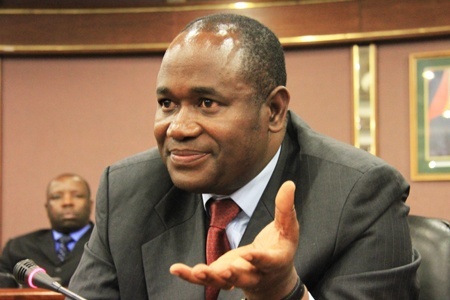
ZIMBABWE imports more than it exports raising fears that the country is accelerating its de-industrialisation, central bank governor Gideon Gono has warned.
BY KUDZAI CHIMHANGWA
Gono’s warning comes at a time the country recorded a trade deficit of US$3,6 billion last year as the economy recorded more imports than exports.
In a monetary policy statement presented last week, Gono said the recovery of exports has remained weak reflecting limited foreign direct investment (FDI) inflows as well as volatile international commodity prices for nickel, platinum, copper and diamonds among others.
“Against this background, merchandise trade remained heavily inclined towards imports of finished consumer goods and vehicles. Exports realised over the period January to December 2012 amounted to US$3,88 billion, which compares unfavourably with imports of US$7,5 billion,” said Gono.
He attributed the country’s increase in import dependence to the persistent supply gaps occasioned by industrial under capacity utilisation.
Zimbabwe’s industrial capacity utilisation levels declined from 57% in 2011 to 44% in 2012,” he said. “It does not require rocket science to appreciate the fact that where a country is relying more and more on importation on finished products, particularly those that it can produce on its own, is on a path of self-destruction and de-industrialisation.”
Gono said 65% of the imports were consumables.
- Letter from America: The death of the Zimbabwe dollar shows the King has no clothes
- Winky D dominates Trevor’s In Conversation
- Letter from America: The death of the Zimbabwe dollar shows the King has no clothes
- Winky D dominates Trevor’s In Conversation
Keep Reading
“Unfortunately whereas one would have expected that there would be a corresponding growth in duties and government inflow arising from taxation from these imports, such a development is not in place,” he said.
He pointed out that the excessive reliance on imports, particularly of a finished nature against subdued export performance has consequently resulted in the incurrence of unsustainably high current account deficits.
Financing of the current account deficit has remained a challenge, as the capital inflows have continued to remain inadequate to finance the escalating current account deficit.
Gono said Zimbabwe was mainly reliant on non-concessional debt flows to finance current account transactions, further worsening the country’s external debt position.
The country is saddled with a US$10 billion debt, to the World Bank (US$1,2 billion), African Development Bank (US$500 million), International Monetary Fund (US$200 million and US$3 billion to the Paris Club of Creditors among other multilateral institutions. The country’s overall balance of payments has also remained in deficit estimated at US$498,1 million in 2012.
In his state of the economy report for December 2012, Finance minister Tendai Biti said exports and imports during December 2012 stood at US$314,8 million and US$665,5 million respectively, bringing the total for the year to US$3,88 billion and US$7,48 billion, respectively.
This scenario gave a trade deficit of about US$3,6 billion, reflecting faster import growth during the period under review and to some extent under-capturing of exports.
University of Zimbabwe Graduate School of Economics professor, Tony Hawkins said the balance of payments deficit was the mirror-image of excessive consumption spending.
He said the economy had become skewed, characterised by excess consumption spending by the private sector and the state, negligible savings and an unsustainable balance of payments position.
“Inadequate investment is the consequence of negligible domestic savings, resulting in a burgeoning foreign debt. Since 2008, we’ve borrowed US$6 billion,” said Hawkins. “The infrastructure deficit, a function of insufficient investment and pervasive political interference in parastatal management links directly to the country’s external debt problem and poor creditworthiness.”
Hawkins said consumption spending was rising as a percentage of gross domestic product (GDP) to 123% in 2011 from 104% in 2009, while FDI under-performed, forcing the country to both borrow excessively offshore and under-invest.
“When viewed in this light, it is obvious that Zimbabwe’s economic problems demand far-reaching, structural reforms that extend well beyond tinkering at the edges of the issue by enhancing policy coordination and improved implementation,” said Hawkins.











